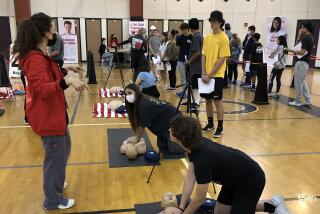Defibrillators Come to the Rescue on Planes and Cruise Ships
- Share via
On a cruise ship on the way from Florida to Mexico last year, 29-year-old Mike Robie and his fiancee, Jody, had just arrived in the dining room when Mike’s eyes rolled back and he collapsed. Jody thought he was seasick.
The problem was more serious. The ship’s doctor and a doctor-guest on board hurried to examine Mike. They performed cardiopulmonary resuscitation, then detected an abnormal heart rhythm. They grabbed an automated external defibrillator (AED), a notebook-computer-size device they used to shock Robie’s heart back into a normal rhythm.
As soon as he was stable, Robie was airlifted to a Florida hospital, where a defibrillator was permanently implanted in his chest. Recalling the incident recently from his home in Massachusetts, Robie said he was grateful that the cruise line had the AED available.
Tourists will likely see AEDs (sometimes hanging on the wall in plain view) at more and more destinations, as well as in more airports. Under Federal Aviation Administration regulations that take effect in 2004, the devices will be in the on-board medical supply kit of every domestic commercial and charter aircraft. And thanks to public access defibrillation programs, promoted under the Cardiac Arrest Survival Act of 2000, AEDs are becoming much more common in federal and other public buildings.
Officials at tourist locations who have decided to add the devices to their medical supply kits are mindful that about 220,000 Americans die each year of sudden cardiac arrest, according to the American Heart Assn., and that AEDs may save some of them. Having the devices on the premises of a tourist attraction may also reduce liability for the facility, decreasing the likelihood of lawsuits claiming that medical supplies were inadequate.
More good news for travelers: Employees at destinations offering AEDs are trained in the use of the device, a session that normally takes four hours or less. And tourists who aren’t trained but may be called on to use an AED should know that laws protect them from liability.
In the past several years, AEDs have become smaller and more affordable, which partly accounts for their growing popularity. A typical unit costs about $3,000, according to the American Heart Assn. Some airlines began carrying AEDs a few years ago, with Qantas Airways and American Airlines considered pioneers in the movement.
Some airports, including Chicago’s O’Hare International and Midway International, followed suit. More recently, Los Angeles International Airport officials decided to place about 100 AEDs in the terminals and in some baggage handling areas, according to Nancy Castles, a spokeswoman for Los Angeles World Airports. (Placement in the terminals is expected to be complete by the end of the year.) In September, the Disney Co. announced that about 500 AEDs are being placed at Disneyland, Walt Disney World resorts and the Disney Cruise Line.
AEDs are designed to restore a normal heart rhythm in those who suffer cardiac arrest. The chances of survival from cardiac arrest decline by 7% to 10% for each minute that passes without defibrillation, according to the American Heart Assn.
Adhesive electrode pads applied to the victim’s chest help sense the electrical activity of the heart. The computer within the AED assesses the patient’s heart rhythm and judges whether defibrillation is needed. If so, the user is prompted by voice and visual commands to deliver an electric shock through the victim’s chest wall with the electrode pads.
If an AED is not immediately at hand, the American Heart Assn. advises that CPR be given first. CPR works by forcibly pumping blood through the heart. The AED works by silencing all the heart’s electrical activity so it can be restarted to a normal rhythm. “It’s sort of like rebooting the heart,” says David Freeman, a spokesman for Philips Medical Systems, an AED manufacturer.
AEDs are prescription devices; under Food and Drug Administration regulations, a physician must write the prescription for an AED and oversee the program. At facilities such as Disneyland and cruise lines, employees who are expected to use the devices attend training classes.
To demonstrate how simple AEDs are to use, University of Washington researchers compared the performance of 15 sixth-graders to that of 22 emergency medical technicians, staging a mock cardiac arrest scenario with mannequins. The untrained children were only a bit slower at using the AED than the professionals, the researchers reported in the journal Circulation: It took the youngsters an average of 90 seconds, compared to 67 seconds for the EMTs. The children also placed the electrode pads appropriately.
Even so, it’s ideal that those who use AEDs or perform CPR be trained. Classes for the public, offered by community groups or such organizations as the American Heart Assn. and the American Red Cross, are becoming more common; there may be a fee of about $30 per person. AED classes are often bundled with CPR training.
What if a traveler encounters an emergency need to use an AED but is not trained in its use and is the only person available to help?
“I would not hesitate to recommend that a lone, untrained rescuer use the AED on a suspected cardiac arrest victim,” says Cherry Cardwell, a spokeswoman for the Public Access Defibrillation League (https://www.padl.org), a Sacramento-based nonprofit organization dedicated to promoting AED use.
Rich Hamburg, director of government relations for the American Heart Assn., agrees: “In general, state and federal laws [including the Cardiac Arrest Survival Act] protect trained or untrained lay responders in emergency situations.”
But experts say that before either AED or CPR is used, it is vital to call 911 so professional medical help can be summoned.
*
Healthy Traveler appears twice a month.
More to Read
Sign up for The Wild
We’ll help you find the best places to hike, bike and run, as well as the perfect silent spots for meditation and yoga.
You may occasionally receive promotional content from the Los Angeles Times.






